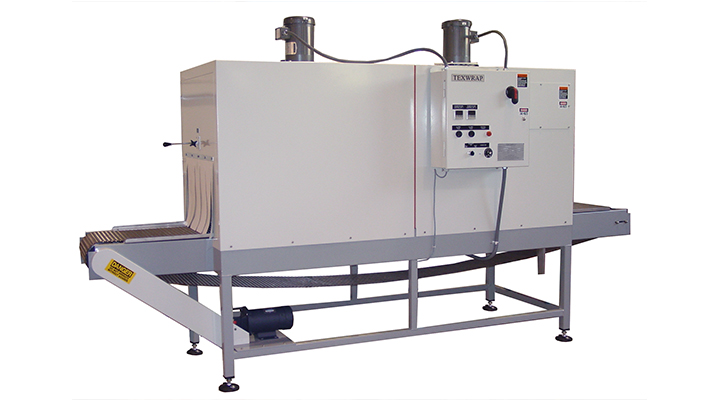
The perfect shrink wrapped package is a combination of correct bag size, amount and placement of perforations as well as the the right heat shrink tunnel machine dynamics for overall air velocity, air direction, temperature and belt speed.
Contrary to popular belief, the heat from a heat shrink tunnel machine does not cause the air in the film bag to expand like blowing up a balloon. Film shrinks when heat excites the molecules in the film allowing them to freely return to their natural state as they were before they were “stretched” during the manufacturing process. As the film starts to contract, the air already inside the film envelope is trapped pushing against the shrinking film. This causes the “ballooning” effect. Probably a “pillow” is a better description of what happens visually.
Explore why you need to think of the right heat shrink tunnel machine
The amount of air in the bag as it leaves the wrapper is directly related to the size. If the bag is too small and has little to no air, small bubbles form with minimal shrink. Often, when it looks like the film is not shrunk completely or the package has wrinkles, the temptation is to think that the reason is that the bag is too big and did not have enough time to shrink. More often, the real problem is that the bag is too small with insufficient air inside which did not allow enough of the pillowing effect for the film to move away sufficiently from the product before it begins to shrink. Of course, the other major factor in adequate bag pillowing is the number and placement of perforations. If air escapes quickly, the pillow will collapse too early and too quickly and the film won’t be fully shrunk. If air does not escape quickly bubbles will stay inflated too long and the film will burn through.
The ideal shrink wrapping cycle
In the ideal shrink cycle, the maximum pillowing happens as soon as the package enters the heat shrink tunnel machine. The film rapidly moves away from the object inside it. Perforations in the film allow the air to begin escaping, shrinking gradually and uniformly until it touches the package. Ideally, film should touch the side, ends and top of the package simultaneously at the last second. When parts of the film touch the package before other parts, uneven shrink can occur. The parts touching early stop the shrinking and may result in wrinkles or “fisheyes” locked which can’t be cleaned. The last parts of the bubble will be completely shrunk and will have an excellent appearance. Tunnels with good air velocity causes bubbles to form early allowing the film to move away from the package immediately forming a completely even shrink.
The pillow should ideally finish collapsing about 3/4 of the way through the tunnel, not before. This allows maximum time for the pillowing effect and leaves minimal time for film “cleanup” to remove the final wrinkles before it exits the tunnel.
Long packages are treated differently
Some packages require extra air into the film tube as it is being formed. Very long packages are an example where the film begins to shrink before the whole package is in the heat shrink tunnel machine. As package enter, the film begins to shrink sequentially from the front toward the back pushing the trapped air rearward. If there isn’t enough air in the tube to keep the front of the bag inflated, the front shrinks poorly. As the package moves, there is enough trapped air to cause the back of the bag to pillow and that end of the package look great. Injecting extra air into the package essentially “pre-forms” the pillow allowing the front end to shrink normally. This technique can also be helpful on very small or thin packages or on packages where appearance is extremely important. These packages might normally have a very small bag. The extra air can sometimes allow just enough extra pillowing to cleanup well for maximum appearance.
